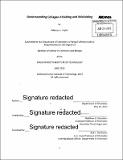Understanding collagen-l folding and misfolding
Author(s)
Taylor, Rebecca J. S.B. Massachusetts Institute of Technology
DownloadFull printable version (8.219Mb)
Other Contributors
Massachusetts Institute of Technology. Department of Chemistry.
Advisor
Matthew D. Shoulders.
Terms of use
Metadata
Show full item recordAbstract
Chapter One: Introduction to Type I Collagen and Osteogenesis Imperfecta Collagen-I is the primary proteinaceous component of skin, bone, and tendon. Disruptions in collagen-I homeostasis, typically due to non-synonymous mutations in collagen-- encoding genes, cause a variety of severe incurable diseases, including Osteogenesis Imperfecta (01). 01 phenotypes include brittle, deformed bones, frequent fractures, and growth deficiency. In order to fill the need for treatments that target the underlying causes of collagen-I-related diseases like 01, a better understanding of the collagen-I proteostasis network and how it differentially engages mutant and wild type collagen-1, is required. Chapter Two: Creation and Characterization of a Cell-Based Platform for Delineating the Wild Type and Mutant Collagen-I Proteostasis Network Previous studies of the collagen biosynthetic pathway have been limited by the lack of a biochemically tractable system to allow manipulation of the collagen-I genes (and other genes of interest) and especially by the lack of immunoprecipitation-grade antibodies for collagen-I which has prevented the broad study of the complete set of collagen-1 interacting proteins. We have overcome the challenges of working with the collagen-I genes and have created stable cell lines that inducibly express epitope-tagged versions of both wild type and mutant collagen-1. This platform is greatly facilitating studies of the collagen-I proteostasis network. Chapter Three: Mechanistic Exploration of Novel Collagen-I Interacting Proteins Identified by SILAC Mass Spectrometry Using the model cell platform described in Chapter 2, we have performed an unbiased and quantitative investigation into the network of collagen-I interacting proteins using SILACassisted, quantitative mass spectrometry. The method allowed us to identify more than 25 novel collagen-I interactors. We are currently investigating the mechanistic roles of these proteins in collagen-I processing using shRNA knockdown of proteins of interest. Chapter Four: Creation and Validation of Constructs for the Independent Expression of the Collagen-I C-Propeptide Domains The collagen-I C-propeptide domains are responsible for collagen-I chain selectivity and triple helix nucleation. Many unanswered questions remain relating to the mechanistic details of C-propeptide function both in collagen-I folding and also in diverse biological processes. In order to address these questions, we created and validated constructs that allow the independent expression of the C-propeptide domains.
Description
Thesis: S.B. in Chemistry and Biology, Massachusetts Institute of Technology, Department of Chemistry, 2015. Cataloged from PDF version of thesis. Includes bibliographical references (pages 74-79).
Date issued
2015Department
Massachusetts Institute of Technology. Department of ChemistryPublisher
Massachusetts Institute of Technology
Keywords
Chemistry.